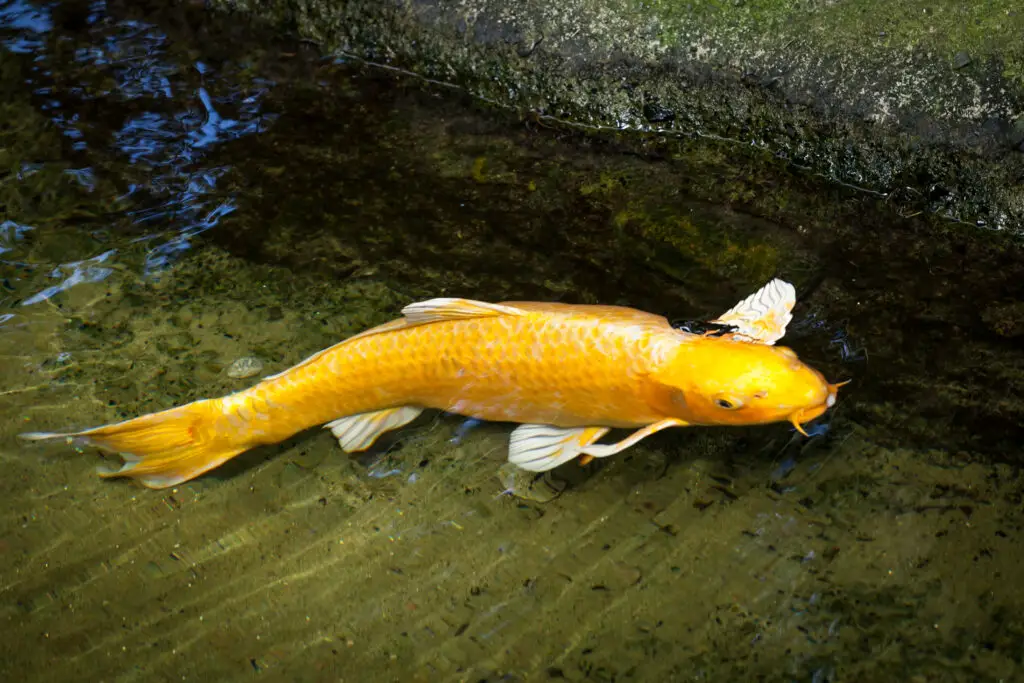
Koi fish are a fantastic addition to any home tank or garden pond. Not only are koi fish attractive to the eye, but they can also be extremely friendly, recognize their owners, and some of them will even eat out of your hand and recognize their names. If you seek a beautiful and easy-to-care-for koi, you can’t go wrong with the Ogon koi. The only question remaining is whether Ogon koi are a friendly variety of koi.
The single-colored Ogon koi are some of the friendliest and most outgoing koi available. Their high intelligence, liveliness, and love of food make them easily tameable. Adding a few Ogon koi to your pond or tank will often make the rest of the koi in your pond friendlier.
If you are a koi fish owner, there is nothing better than having a school of friendly koi that come to you at feeding times and display signs of affection towards you. For this reason, knowing which varieties of koi will exhibit a more friendly nature is a bonus. Ogon koi are some of the friendliest koi, and there are several sub-variations from which you can choose.
How Friendly Are Ogon Koi?

Ogon koi are particularly intelligent and very friendly. Their love of food, which makes them slightly aggressive during feeding time, and their friendly nature make them ideal candidates to train to eat out of their owner’s hands. With a little bit of dedication, you should be able to get your Ogon koi to come when called by their names and eat out of your hand in no time.
You will probably find that your other koi will follow suit once your Ogon koi start to hand-feed. So if you would like to ensure that you have social interactions with your koi, it would be a great idea to get a few Ogon koi in your mix.
Ogon koi is a unique variation of the ornamental koi because of their super friendly nature and unique colorations. Let’s delve into some Ogon koi history and interesting information.
Some Interesting Facts About The Ogon Koi
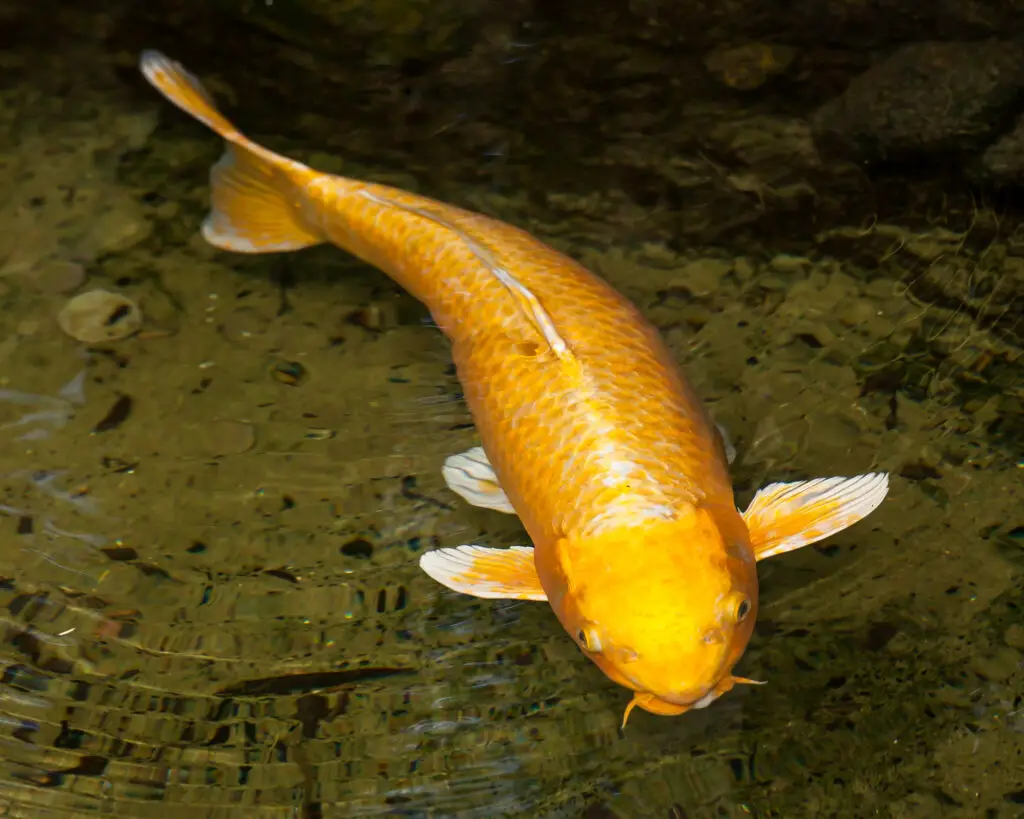
Ogon koi are relatively recent additions to the koi family, having been bred around 1946 after a 25-year breeding and cross-breeding endeavor. The precursor of the Ogon koi appeared around 1921 in the form of a dark-colored wild carp that had a gold stripe down its back. Over the next two decades, this wild carp variant was cross-bred with ornamental koi to produce the spectacular metallic single-colored Ogon koi.
The spectacular single-coloration and the metallic sheen of these Ogon koi make them a popular choice for koi ponds, as their color shows up well in the water. The recent cross-breeding of these koi with wild carp means they often grow larger than other ornamental koi varieties.
Ogon koi are also some of the healthiest koi you will find. Their good health comes down to the fact that they are genetically more immune to diseases or parasites that affect many other variants of ornamental koi. Their added immunities often result in them enjoying longer lifespans than other ornamental koi varieties.
When choosing Ogon koi for your koi pond or tank, you are truly spoiled for choice, as there are several sub-varieties from which to choose. There are two main Ogon koi sub-variations: the Purachina Ogon and the Yamabuki Ogon. Rarer sub-variations include the Orenji Ogon, Matsuba Ogon, Nezu Ogon, Kuro Ogon, and Mukashi Ogon.
Let’s look at what makes each of these variants unique.
- Purachina Ogon: Other names include the Platinum Ogon and the Ghost Ogon. This sub-variation is a solid metallic white koi fish.
- Yamabuki Ogon: These are either solid metallic gold or yellow. If you are fortunate, you might even come across one of the rare neon yellow sub-variants.
- Orenji Ogon: These are metallic orange-toned with white fins, but some individuals will have orange spreading out into the white of the fins.
- Nezu Ogon: This koi is silvery-grey in color and is considered an older sub-variant of the Ogon.
- Kuro Ogon: This sub-variant of Ogon koi is black in coloration.
- Mukashi Ogon: This sub-variant of the Ogon koi is rare and bronze in coloration.
- Matsuba Ogon: A newer sub-variant of the Ogon koi, the Matsuba Ogon features a thick pinecone textured stripe of scales down their backs. The pinecone textured scales are a darker hue than their base color, reflecting the colors of the previously mentioned Ogon sub-variants: white, orange, yellow, and gold.
What Is The Friendliest Koi?
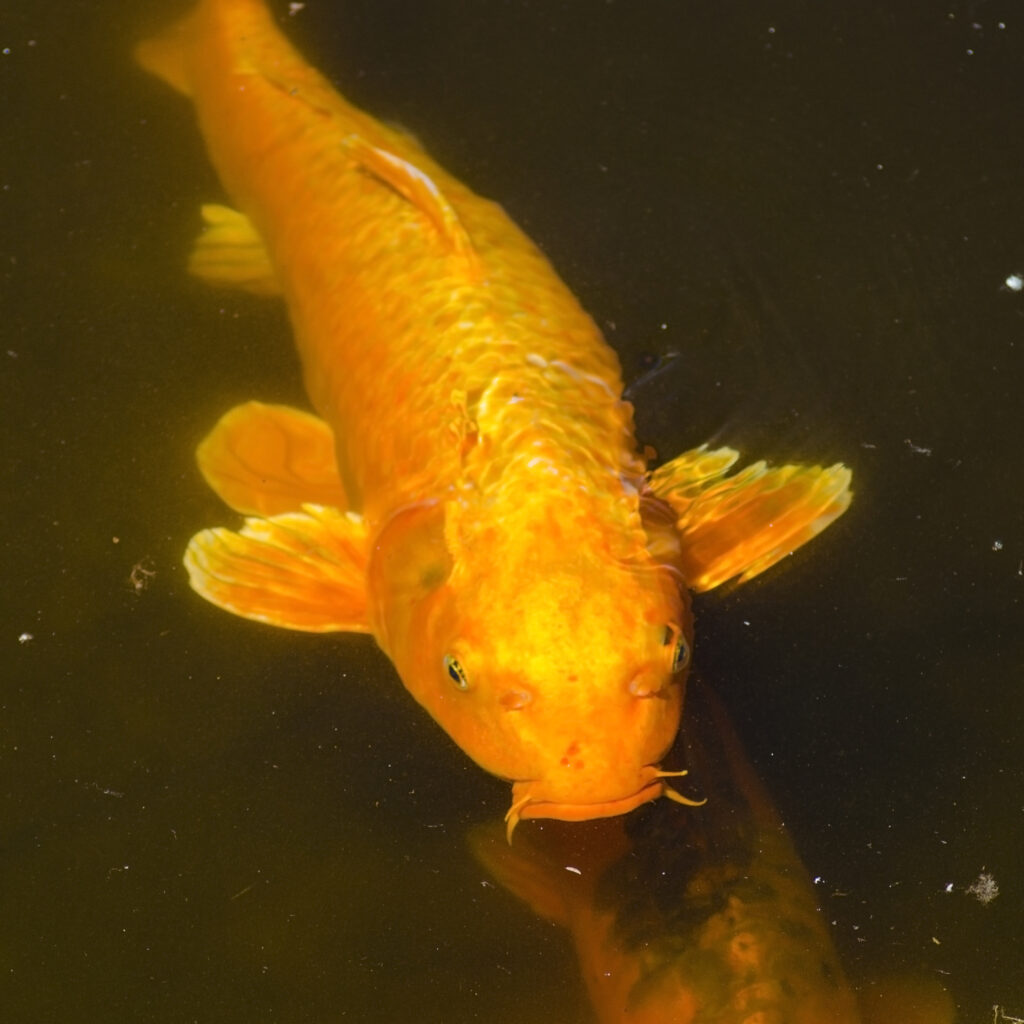
The consensus indicates that the Chagoi koi is the friendliest variation of the different kinds of koi fish available today. Chagoi koi are also the most docile of the koi variations. Many Chagoi koi owners have noted that their Chagoi is so friendly that they will seek out human interactions, going so far as allowing their owners to hold and pet them.
Koi owners have also noticed that their Chagoi koi are the first to be comfortable with hand feeding. Their docility and calm encourage the other koi in the pond to become friendlier towards their owners. They are also noted as being the most aggressive at feeding times, often the first to arrive on the scene when it’s feeding time.
When it comes to the Chagoi koi, you might overlook them due to their inferior or common colorations. They have no spectacular bright colors or beautiful patterns that might set them apart from the other koi. Their coloration usually extends to brown, green, and reddish-brown shades, with a rare beige or cream.
Chagoi koi coloration varies slightly with some sporting fukurin, a pretty scale reticulation, where each scale is traced in a very thin black line, making them stand out. However, this reticulation is rather faint. And others sport no fukurin.
Chagoi koi grow rather large, and they are the fastest-growing variation of koi. The average size of a Chagoi koi is around 40 inches, and they reach this length at a much faster rate than other koi variations. But their size and growth rate do not compare to their lovely personalities and friendly, docile nature, making them great additions to any koi pond.
There are a few sub-variations of Chagoi koi coloration, which we will take a look at below:
- Green Chagoi: Many have found that the best type of Chagoi are tan-greenish when they are young, less than 3 – 4 years old. After this point, these often turn brown with a final amber-blonde tone, which is superior to the typical plain brown Chagoi. Many koi owners note that this sub-variation is the friendliest of all the Chagoi koi and appears the hungriest at mealtimes. Green Chagoi koi are available with and without fukurin.
- Rootbeer Chagoi: These Chagoi are an intense reddish-brown coloration and are available with and without fukurin.
- Chagoi-Utsuri: These koi, also called Cha-Utsuri, are brown in coloration but have a black fukurin pattern and black smudges across their bodies.
- Brown Chagoi: This is the most common sub-variant of the Chagoi koi. If you decide to purchase a brown Chagoi, you should go for one with fukurin if you want it to be distinguishable from the common carp.
When looking for a friendly koi, keep in mind that each koi is unique. All koi have particular personalities, and you might find that some Ogon koi or Chagoi koi are not particularly friendly due to that specific koi’s personality. If you are looking for a friendly koi, the most social is often the largest koi with voracious appetites. This love of food will usually make them more comfortable with your presence as long as you keep supplying them with a good meal.
How Do You Make Your Koi Friendly?
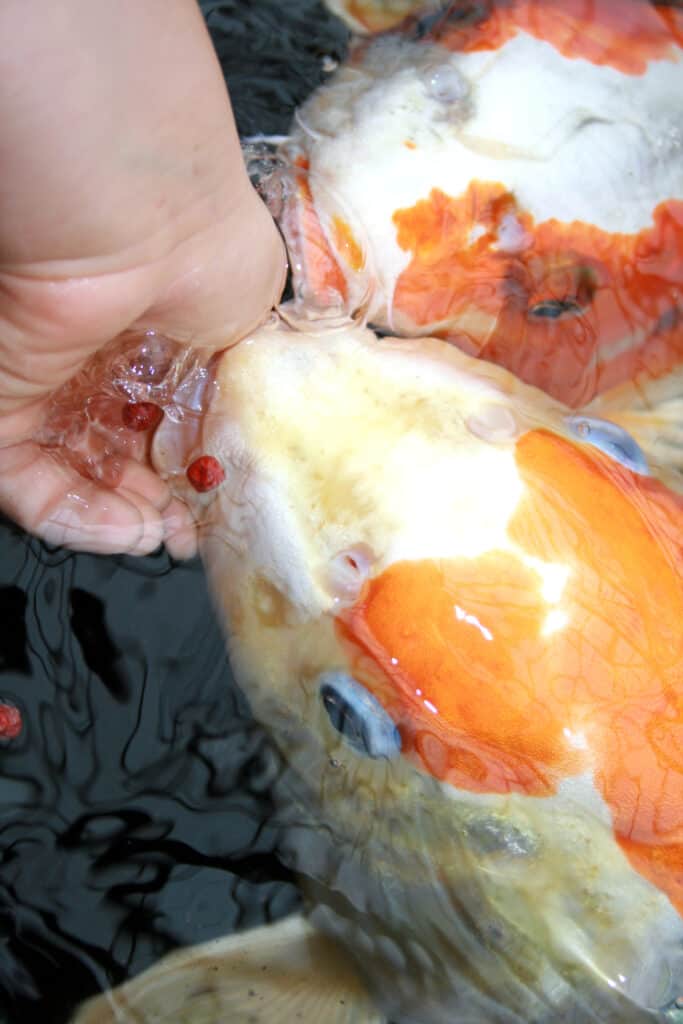
Koi fish are intelligent creatures that will respond to your actions and how you treat and interact with them. Like many other species of animals, koi can often be shy at first, and it will take a little bit of persuasion from you to make them realize that you are their friend and that they can interact with you without having to worry.
Given enough time and patience on your side, you can help your koi develop their confidence and personalities. This development often leads to your koi becoming more playful and curious and might even be bold enough to eat out of your hand.
Promoting Friendliness Amongst Your Koi: Preparation
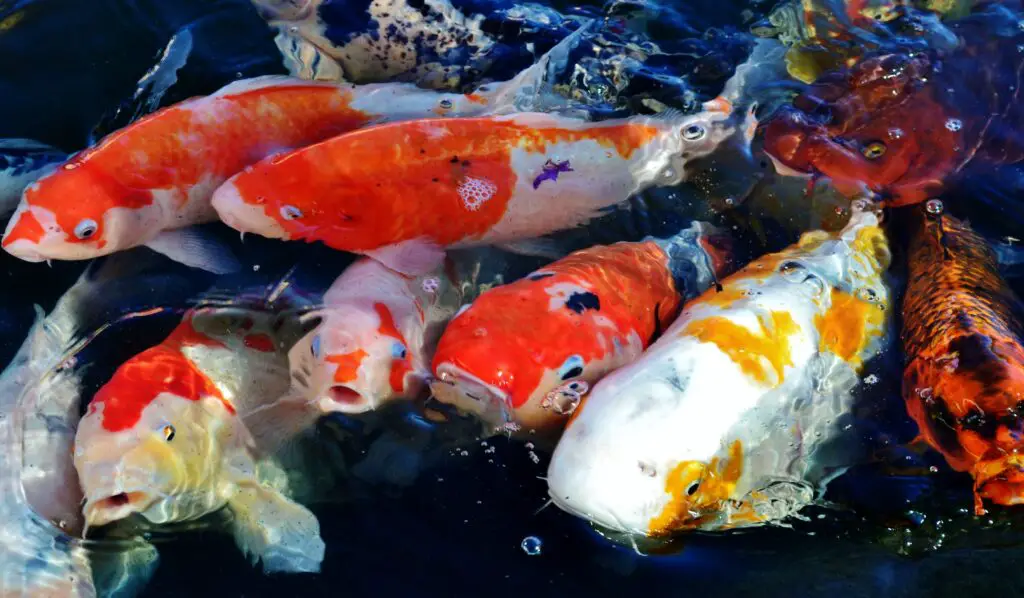
If you are looking to develop a relationship between yourself and your koi fish, there are a few steps that you can take to provide them with the right environment to promote friendship.
Step 1:
Ensure that you are constantly feeding your koi good quality food, nutritionally balanced and tasty. It is also good to give your koi the odd treat or two.
Step 2:
Ensure that your koi feel safe in their pond environment. You can provide your koi with a deep enough pond to retreat to the bottom if they feel nervous or in danger. You can also offer hiding places such as rock ledges, plants, fish shelters, and tunnels.
Step 3:
Ensure that you maintain good water quality in the pond. Check your temperature, pH levels, and water hardness, adjusting as is necessary. You can also ensure good water quality by installing a decent water filtration system and incorporating more plants.
Step 4:
There is truth to the saying: there is safety in numbers. Adding a few more koi to a small group or ensuring that you have a decently sized koi school in your pond will make your koi feel more comfortable. Throw in a Chagoi or an Ogon koi, and you might find that the rest of your koi feel friendlier towards you.
Promoting Friendliness Amongst Your Koi: The Steps
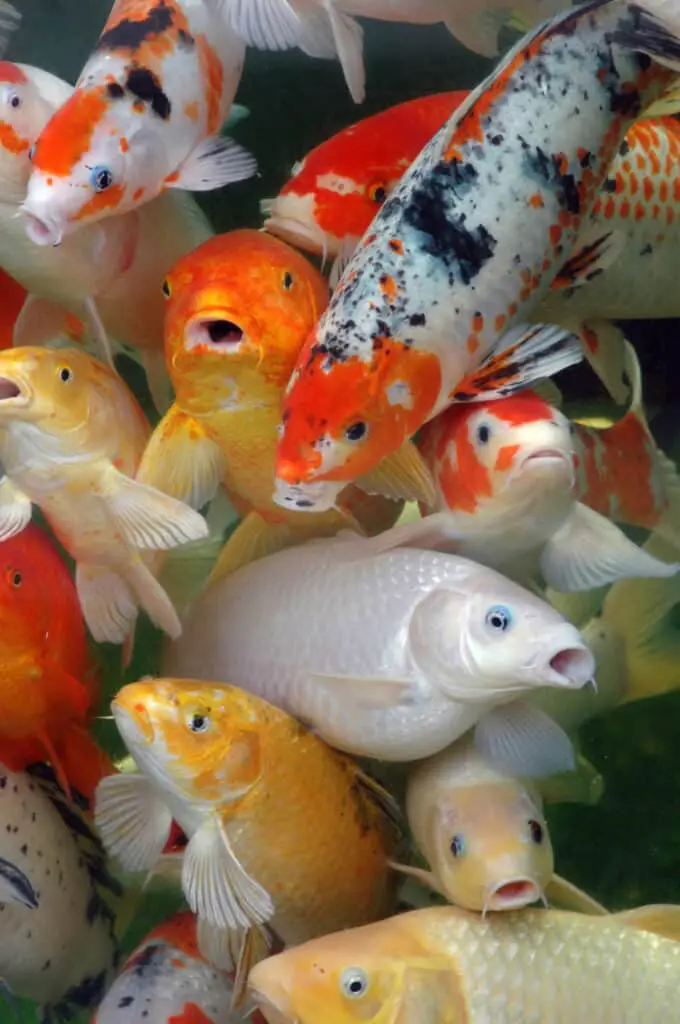
The following guidelines should enable you to build a relationship with your koi, with the primary aim being that they are willing enough to eat out of your hand and come to the surface when you visit them. One thing to remember is that route is the key. If you maintain a designated feeding routine, your koi will become accustomed to this route and feel safer.
Step 1:
Begin by feeding your koi as usual but remain close to the pond’s edge while they feed. If you find that your koi are unwilling to approach the food or back away when noticing your presence, slowly move away from the pond’s edge, giving them some room.
Once they begin to eat, you can slowly ease your way back to the pond’s edge. Whether you do this during that particular feed or ease your way back over a few meals is up to you and your koi. You can also use your visiting time when you give them their tastiest treats, and they will start to associate your presence with these treats.
Step 2:
It would be best if you chose to sit in the same place when feeding them. This way, they will know to associate that place with food, and they will start to go there in anticipation when they see you. Feed them a smaller amount of food. Once your koi have eaten all of the food, get up and go and get some more food.
Repeat this process several times and over a few days until your fish become comfortable with your presence. Once it appears that they are comfortable with you, try placing one of your hands into the water, ensuring that it is properly clean. Leave your hand there, holding it still while your koi get used to its presence in the water.
Step 3:
Once you feel like your fish are comfortable with your hand in the water, you can start trying to get them to eat out of it. You can do this by holding some pellets or tasty treats inside your hand while holding it in a fist. One of the best treats for this is shrimp. You can give them a little squeeze so that the juices come out of your fist, swaying your fist to and fro in the water, displacing the fluids to attract your koi.
If you have chosen to use pellets or other food, allow some of it to escape your hand so your fish can eat it but don’t have to take the food from your hand just yet. Continue this process for a few meals. Eventually, your fish will ascertain that the food comes from your hand.
Once they are comfortable approaching, you might find that they will nudge your hand to see if it will release more food for them. If your koi do this, you can allow a few more morsels to escape your fist and stop if they don’t seem interested in the released food. This way, you are ensuring that they don’t feel forced.
Eventually, you will be able to open your hand, and your fish should eat from it. This bonding process could take days or even weeks of continuous effort on your part. Patience is vital, and the rewards will be worth it.
Conclusion
Ogon koi are particularly intelligent variants of koi fish. They are also very docile and friendly koi, and these characteristics are excellent for any pond environment as it promotes friendliness in the other koi in your pond. In some cases, particular Ogon koi might be happy to even eat out of your hand, encouraging similar behavior amongst the other koi. If you can’t get an Ogon koi for your pond, then the Chagoi koi are also an excellent choice, as many hail it as the most friendly of all the koi variants.
References
https://www.aquariumdomain.com/SpeciesProfiles/Koi/PlatinumOgonKoi.shtml
https://ezinearticles.com/?Amazing-Facts-About-Ogon-Koi&id=5361392
https://myemail.constantcontact.com/News-from-Hanover-Koi-Farms.html?soid=1102276788717&aid=NiNCIhqJm5khttps://www.youtube.com/watch?v=WVIyjcpA1MY


